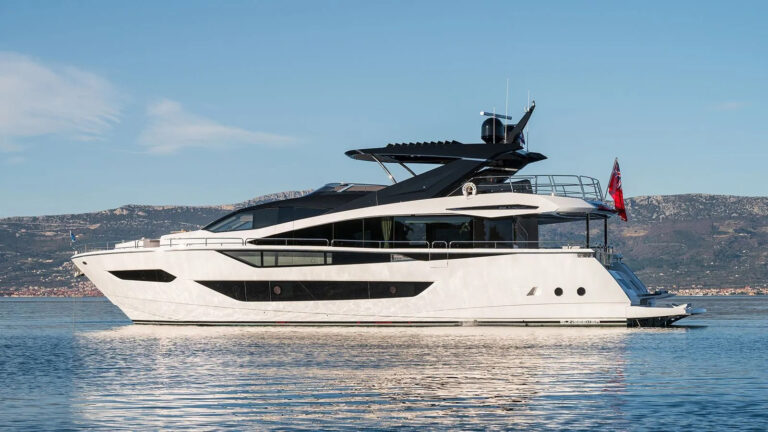Uniden’s new Mystic is a full-function VHF/DSC radio with an integral Magellan-supplied, WAAS-capable GPS navigator/chart plotter and a SAME programmable VHF weather channel receiver. It puts a complete communication/navigation system into your hand.
The maker’s decision to provide full DSC capability in the Mystic is well timed, because the Coast Guard expects to activate the Rescue 21 communication system late this year or early in 2005. The Mystic then will be able to send an internationally recognized mayday call, also instantly announcing the boat’s identity and precise location. The DSC function will enhance routine communication, eliminating the need to hail stations on channel 16 and providing instant exchange of position information. VHF communications will resemble cellular telephones, with ring tones, Caller ID and a log of unanswered incoming calls.
The Mystic provides all of the communication capability and convenience expected in a high-quality VHF, including one-click switching between channels 9 and 16, a triple-watch mode that monitors channels 9 and 16 and one of your choice, and programmed scanning of selected channels. The radio transmits on all 54 available channels at a 5-Watt or 1-Watt power level, and receives on a total of 80 channels, including all of the weather channels. When the Mystic is not receiving or transmitting on a voice channel, it silently checks channel 70 for DSC calls. All incoming distress calls are logged, and the position of the most recently received call is plotted with a “wreck icon on the chart screen. Routine DSC calls not answered within five minutes are logged into the 30-number-capacity call waiting list.
Specific Area Message Encoding (SAME, also identified as FIPS Codes in the owner’s manual) enhances the value of the Mystic’s weather broadcast receiving. Warnings of severe weather can cover very large areas, often resulting in an alert that does not apply to your surroundings. Programming the radio with the SAME code for your area (get the code numbers are from www.nws.noaa.gov/nwr) will ensure that you receive only those warnings appropriate for your location.
The Mystic has three operating modes: Marine Only, (functions as a normal VHF/DSC); GPS Only (works as a GPS navigator); or a combination of radio and GPS/chart plotter. Programming and control is via 11 clearly marked, if small, keys (six of which are dual-function) and a four-way cursor. Two coaxial rotary knobs for Power On/Off, Volume and Squelch are on the top of the radio. You may program the communication and navigation functions to match any operational and data display needed. Programming is a bit tedious, but the owner’s manual and Help menu provide clear instructions.
A total of 10 display options are available: one for VHF operation plus nine to serve the navigation mode (map, compass, large data screen, two position screens, road screen, data screen, speedometer screen and satellite status). The Mystic’s 9.4 MB North America base map provides surprisingly detailed information on marine navigation aids. The basic package includes a MapSend Streets and Destinations USA CD and a cable that connects the serial port on a PC to the Mystic’s removable mounting/charging base. For terrestrial navigation, portions of this mapping resource can be uploaded to the memory. A Mystic purchased with a Magellan BlueCharts CD can upload detailed marine charts once the user has obtained the unlock code from Magellan’s Web site. The process is not fully detailed in the manual, and it should be. I was ably assisted by Uniden’s senior technician.
With the marine chart for my home waters loaded, I found the Mystic’s GPS navigation and chart plotter provided all the functions I expected from a Magellan chart plotter. The only limitation is the small screen.
I programmed the Mystic with a Maritime Mobile Service Identity number, available at no cost from Boat/U.S. (www.boatus.com or 800-563-1536) and used it to communicate between my tender and ketch. All the DSC functions worked properly. Only a few of the less critical DSC features, such as including the number of people on board or the reason for a mayday call, are absent from the emergency call library. The Mystic displays this data if it is contained in a monitored distress call.
The more I used the Mystic, the more I liked it. I would improve the LCD by making its rear reflective surface brighter. I think the value of the radio, and in particular the chart plotter, would be greatly enhanced by a color transflective screen similar to those used on many PDAs. I would also like to be able to progress through the display screens in forward and reverse directions. The Volume and Squelch control knobs on the unit I tested tended to move together-a bit more separation and a higher detent force for the volume knob will help. I did not test the radio with the optional remote speaker/mic but believe it will be useful with the radio locked into its charging base on the tender. In my opinion the multiple capabilities of the Mystic fully match its “super-size. Price: with MapSend Streets & Destinations CD, $400; with MapSend Streets & Destinations and MapSend BluNav CD North America, $500.
Contact: Uniden, (817) 858-3415; www.uniden.com.
Click here to buy Uniden products.









